#charles baskerville
Text
the way I wanna write blitz enders/charles baskerville but can't bc there is literally nothing I can find about their characters other than evil person who likes torturing children and hating the working class :(
and there's no ship name..
#moriarty the patriot#yuumori#yuukoku no moriarty#ynm#blitz enders#charles baskerville#whats their ship name
9 notes
·
View notes
Text





#never#never expect me to forgive them for not including this in the anime#torturous#yuumori#yuukoku no moriarty#yukoku no moriarty#william james moriarty#ynm william#sherlock holmes#ynm sherlock#louis james moriarty#ynm sebastian#sebastian moran#fred porlock#ynm fred#ALSO WDYM HE'S SMILING AT THE KIDS BEFORE SLAYING (THE MAN)#charles baskerville
46 notes
·
View notes
Text
The most evil Sherlock Holmes villain: champions edition
Hello beloved thots. The results of the semi-finals are in, so now you can vote for your favourite overall villain
#sherlock holmes#john watson#johnlock#sherlock#watson#superwholock#acd holmes#acd sherlock holmes#acd johnlock#sir arthur conan doyle#poll#tumblr poll#the hound of the baskervilles#the adventure of the speckled band#the adventure of the greek interpreter#the adventure of charles augustus milverton#the adventure of the dying detective#the adventure of the illustrious client
23 notes
·
View notes
Text

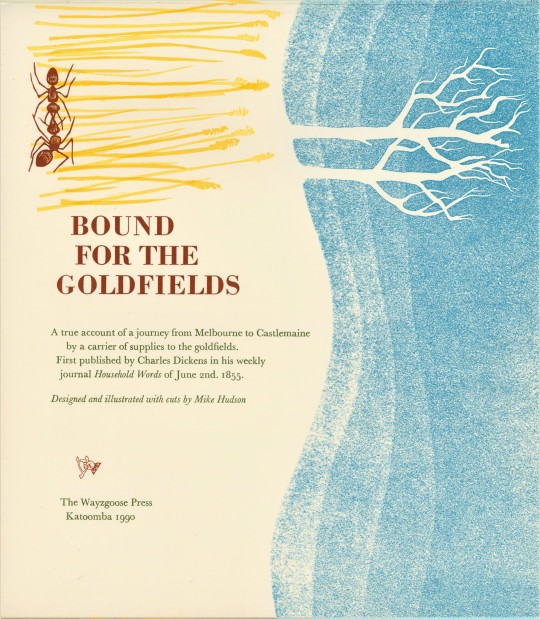








It's Fine Press Friday!
For today’s Fine Press Friday post, our subject is Bound for the Goldfields, published by the Australia-based Wayzgoose Press in 1990 in an edition of 55 copies, another gift from the estate of book artist and collector Dennis Bayuzick. The original story was written by Charles Dickens for his weekly journal Household Words in June 1855 and the Wayzgoose edition was designed and illustrated with linocuts and wood engravings by Wayzgoose founder Mike Hudson (1939-2021). Ours is a review copy, meaning that this specific book was originally sent out to someone to be reviewed for publication before it was actually distributed.
According to the title page, the story told in this book is a “true account of a journey from Melbourne to Castlemaine by a carrier of supplies to the goldfields.” A journey like this was long and harrowing, as described in the book’s text, which is printed vertically as part of the grassy landscape, and the wood/linocuts provide an excellent visualization of where the traveler physically is within the story being told. Readers will see many trees as the subject walks through forests, sees the night sky, and even the destination of the traveler as he arrives: the tents of those working in the gold fields.
This book was hand-set by Hudson's long-time partner and Wayzgoose Press co-founder Jadwiga Jarvis (1947-2021) in 14pt Monotype Baskerville and was printed on a Western Proof Press using Mohawk Letterpress Paper. Mike Hudson Bound the edition, 46 copies of which were in printed hessian fabric with leather thongs, as shown here.
View other books from the collection of Dennis Bayuzick.
View more Fine Press Friday Posts.
-- Sarah S., Special Collections Graduate Intern
#Fine Press Friday#fine press fridays#letterpress printing#fine press books#Wayzgoose Press#Bound for the Goldfields#Charles Dickens#gold mining#Mike Hudson#Jadwiga Jarvis#Monotype Baskerville#Mohawk Letterpress Paper#Western Proof Press#hessian fabric#Sarah S.
19 notes
·
View notes
Text

The books I read while clinging to sanity by my fingertips. I didn't get enough read during either month to warrant their own posts, I was just too busy and way too stressed, so here's my November and December reads combined.

The Animal Rescue Agency: Cast File: Little Claws
I’ve been on an Eliot Schrefer kick, though so far I haven’t read anything that topped Queer Ducks for me. This was a very cute youth novel about the dashing Esquire Fox, who runs the Animal Rescue Agency, who are sworn to help any animal in need. In this first case, Esquire — and her fussy rooster friend, Mr Pepper — find themselves adventuring out into the arctic to rescue a baby polar bear from a sinister poacher.
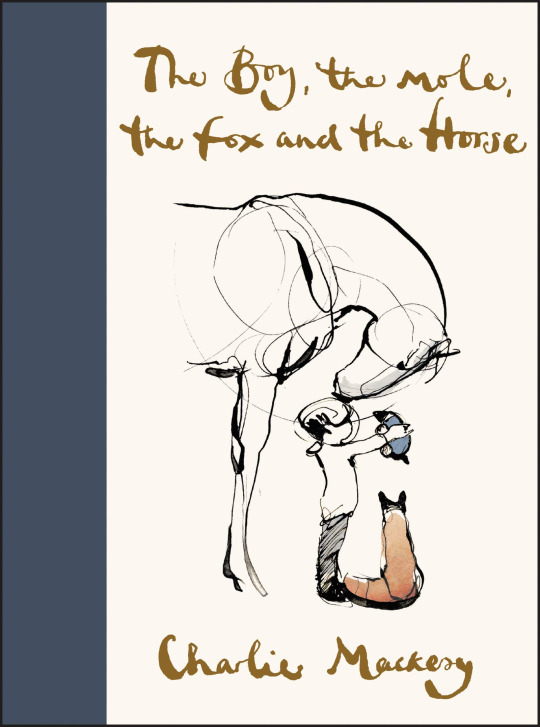
The Boy, the Mole, the Fox and the Horse
I’ve seen this book celebrated but didn’t really know much about it. I bought it on a whim, wanting something cosy to read, and it delivered. It’s a collection of little passages that form a loose narrative, and is centred around being a positive, uplifting view of life. It occasionally feels a little trite, but ultimately if you’re willing to take it for what it is without being overly critical, it was a very charming experience. It has an old-fashioned Winnie-the-Pooh vibe, and the artistry of each page is lovely, so combining that with very gentle and loving affirmations it makes a nice book to sit under a blanket and read on a rainy day.

Chitty Chitty Bang Bang
My mom found her old, original copy of Chitty Chitty Bang Bang from when she was a kid, and since this was something I had been meaning to read for years I decided now was the time. You can definitely see Ian Fleming’s fingerprints all over it — who doesn’t love a cool, gadget-y, semi-sentient car in a battle against horrible mobsters? Add some explosions, a bit of flying, and a sweet shop theft, it really is a fun little adventure. Very different from the film, but both are good in their own unique ways.

A Christmas Carol
I love reading a Christmas novel in December but it was way too busy for me to do anything new or complex this year, so I decided to reread A Christmas Carol. You really can’t go wrong with it, Dicken’s turns of phrase and the way he portrays humanity is wonderful and it just pulls you right in. It’s such a quick, fun read that I really do recommend anyone who enjoys the films to give it a try — it’s not as intimidating as it might seem.

Failed Princesses v6
Finally, the last volume of the series! It was very overdramatic but in a quintessentially shoujo way. If you’ve ever wanted an almost cliche shoujo, but with lesbians, then this is the series for you. It starts with two very different girls — a prep and a nerd, essentially — finding themselves pushed together and slowly developing a friendship as they try to understand the other’s point of view and way of living life. As the series progresses, so do their feelings for one another.
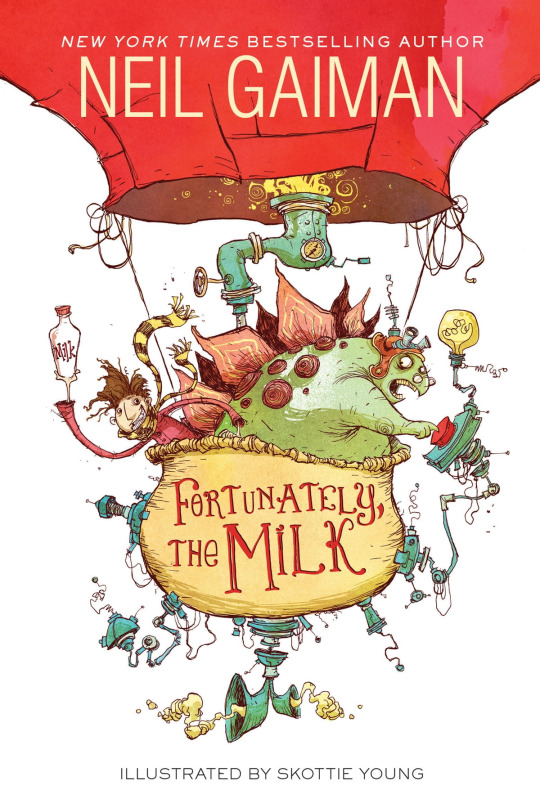
Fortunately, the Milk
An absolutely hilarious novella about a father and his excuses for being a little late getting home from the shop with the milk his kids need for breakfast. Obviously it’s not because he got chatting with a friend, no, he was definitely dedicatedly on his way home, absolutely determined to save his children’s milk-less breakfast, only to be abducted by aliens… and it gets sillier from there. A very fast, very adorable read; it had me grinning the whole way through.

The Original Adventures of Hank the Cowdog
This was a series I remember loving as a kid but haven’t seen since. I stumbled across the first book again and decided to see if it stood up to what I remembered. In some ways it very much did! It’s about Hank, a cowdog who takes his job as Head Of Ranch Security very seriously… but unfortunately does have the intelligence of an average dog and more often than not gets himself into a lot of fuss and bother. It’s a fun mystery adventure, written to mimic a jaded private eye and the humour that a child might miss comes through for any adults reading it. Unfortunately, they’re portrayal of First Nations oh, sorry, I mean coyotes, is seriously very, very uncomfy. Like, deeply racist. So… probably wouldn’t recommend, leave it as a childhood memory.

Nintendo Adventure Books: Leaping Lizards
My brother has an old copy of a Nintendo choose your own adventure book so we decided to sit down and play it over the holidays. Written in the Super Mario Bros 3 era, this book is just completely buckwild, and the results of your choices are completely bizarre. Did it make sense? No. Was it well written? Also no. Did we laugh a lot while reading it though? Yes, it was a blast.

Orphaned
More Eliot Schrefer. This story is about a young gorilla named Snub, who lived back in prehistoric Africa and had never seen a human before… until catastrophe strikes and she finds herself separated from her family and forced to care for her little brother as these strange human creatures stalk the trees. But when Snub sees the humans violently cast out one of their own, she has a challenging decision to make. Schrefer really seems to know what he’s talking about when it comes to animals, and I like how this book is handled. It’s not a “talking animal” book, and he does a great job of portraying the world as a young gorilla like Snub might perceive it.
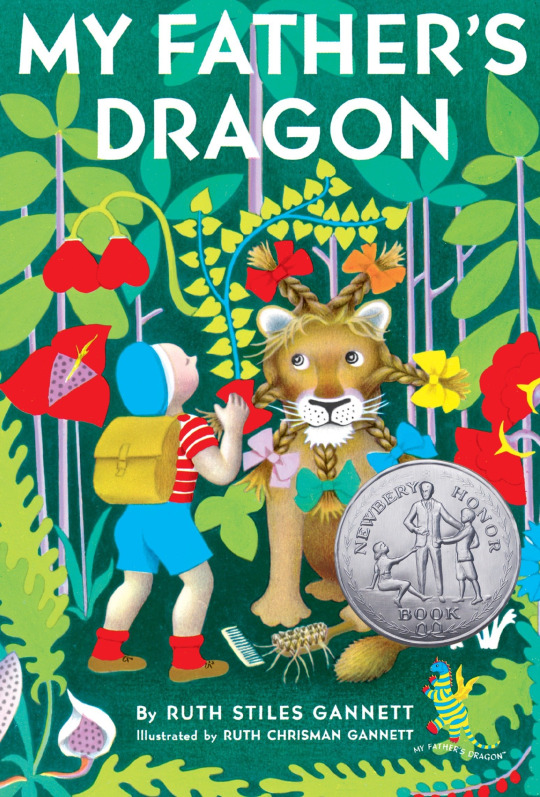
My Father’s Dragon
It’s been turned into a Netflix film, so of course I had to go find the book before watching the movie. The book was charming, and had that very classic 1940s kidlit vibe. Did not bother explaining any of the weirdness, just a had a fun time taking you on an adventure to Wild Island, where the narrator’s father sets about with only his cunning and a strange mishmash of supplies to try to rescue a young dragon who had been enslaved by the other animals.
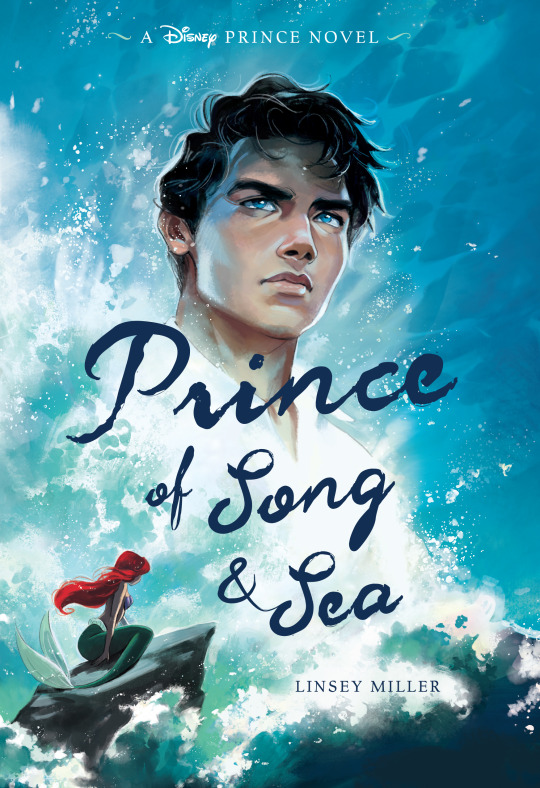
Prince of Song & Sea
I was hesitant about this book — I was never a huge Little Mermaid fan and every Disney prequel, sequel, triquel is wearing on me — but I’m pretty much willing to follow Linsey Miller wherever she intends to go. And I was pleased that I did. This book focuses on the story of Disney’s Little Mermaid as told from Prince Eric’s point of view, but with a bunch of new world building and twists built into it. In this version, Ursula is a much more pervasive and threatening force, and Eric has to figure out how to protect his little kingdom from encroaching threats, fend off the increasing pirate threat, and deal with his own curse that is related to his mother’s early death. Honestly, my main complaint is that it is inherently Disney. The weakest parts of the book came from Miller’s interesting characters and lore bump up against the “pre-rendered” Disney scenes — they didn’t always mesh that well and it left me floundering occasionally. Honestly, it made me wish this was just a pure re-imagining without the movie baggage at all. But! I can’t fault anyone from getting that ~*Sweet Disney Money*~ and I honestly don’t think anyone could have handled this better. I enjoyed reading it.

The Hound of the Baskervilles // The Return of Sherlock Holmes
Well, my last month has been, in a world, hell. So we’ve returned to the ultimate comfort media: Sherlock Holmes. I reread Hound and The Return of Sherlock Holmes and I’ll probably be continuing with this into the New Year because my personal hell doesn’t look like it’s gonna let up any time soon.
#book review#book reviews#sherlock holmes#hound of the baskervilles#my father's dragon#eliot schrefer#orphaned#gorillas#luigi#mario#nintendo#choose your own adventure#hank the cowdog#neil gaiman#fortunately the milk#failed princesses#shoujo#manga#a christmas carol#charles dickens#chitty chitty bang bang#ian fleming#little mermaid#the boy the mole the fox and the horse#animal rescue agency#queer lit#chatter
17 notes
·
View notes
Text
Unraveling the Mystery: A Review of "The Hound of the Baskervilles" by Arthur Conan Doyle
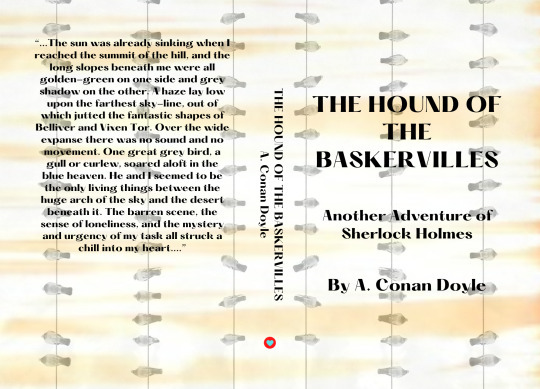
"The Hound of the Baskervilles" by Arthur Conan Doyle is a gripping mystery that continues to captivate readers with its masterful storytelling, intriguing characters, and atmospheric setting. Published in 1902, this iconic novel follows the legendary detective Sherlock Holmes and his loyal companion Dr. John Watson as they investigate the mysterious death of Sir Charles Baskerville and the curse that haunts the Baskerville family.
At the heart of "The Hound of the Baskervilles" is the enigmatic figure of Sherlock Holmes, whose brilliant deductive powers and keen observational skills are on full display. As Holmes and Watson delve into the dark secrets of Baskerville Hall, they encounter a web of deception, intrigue, and superstition that threatens to engulf them in its sinister embrace. Doyle masterfully builds suspense throughout the novel, keeping readers on the edge of their seats as they follow Holmes and Watson on their perilous quest for the truth.
One of the most striking aspects of "The Hound of the Baskervilles" is its evocative setting on the desolate moors of Dartmoor. Doyle vividly brings the rugged landscape to life, painting a haunting portrait of fog-shrouded moors, eerie marshes, and ancient ruins. The atmospheric setting serves as a backdrop for the novel's chilling events, adding an element of gothic horror to the mystery and heightening the sense of tension and dread.
Moreover, "The Hound of the Baskervilles" features a cast of memorable characters, each with their own secrets and motivations. From the enigmatic Sir Henry Baskerville to the sinister Stapleton family, Doyle creates a diverse array of characters that adds depth and complexity to the story. The interactions between Holmes and his adversaries are filled with intrigue and suspense, as the detective matches wits with some of his most formidable foes.
In addition to its thrilling plot and compelling characters, "The Hound of the Baskervilles" is also a meditation on themes such as inheritance, family legacy, and the power of superstition. As Holmes unravels the mystery surrounding the curse of the Baskervilles, he confronts the darker aspects of human nature and the destructive force of fear and superstition. Through the character of Dr. Watson, Doyle explores the role of reason and rationality in the face of irrational beliefs and irrational fears, ultimately affirming the triumph of logic and scientific inquiry over superstition and ignorance.
In conclusion, "The Hound of the Baskervilles" is a timeless classic that continues to enthrall readers with its blend of mystery, suspense, and gothic atmosphere. Doyle's masterful storytelling, vivid characterization, and atmospheric setting make this novel a must-read for fans of detective fiction and gothic literature alike. With its enduring popularity and universal appeal, "The Hound of the Baskervilles" stands as a testament to Arthur Conan Doyle's genius as a storyteller and his enduring contribution to the canon of English literature.
"The Hound of the Baskervilles" by Arthur Conan Doyle is available in Amazon in paperback 16.99$ and hardcover 22.99$ editions.
Number of pages: 272
Language: English
Rating: 9/10
Link of the book!
Review By: King's Cat
#The Hound of the Baskervilles#Arthur Conan Doyle#Sherlock Holmes#Dr. John Watson#Mystery#Detective fiction#Gothic atmosphere#Dartmoor#Baskerville Hall#Sir Charles Baskerville#Curse#Superstition#Suspense#Deduction#Investigation#Fog#Moors#Stapleton#Grimpen Mire#Grim atmosphere#Legend#Thriller#Crime#Intrigue#Classic literature#British detective#Characterization#Plot twists#Dark secrets#Family legacy
0 notes
Text
Unraveling the Mystery: A Review of "The Hound of the Baskervilles" by Arthur Conan Doyle

"The Hound of the Baskervilles" by Arthur Conan Doyle is a gripping mystery that continues to captivate readers with its masterful storytelling, intriguing characters, and atmospheric setting. Published in 1902, this iconic novel follows the legendary detective Sherlock Holmes and his loyal companion Dr. John Watson as they investigate the mysterious death of Sir Charles Baskerville and the curse that haunts the Baskerville family.
At the heart of "The Hound of the Baskervilles" is the enigmatic figure of Sherlock Holmes, whose brilliant deductive powers and keen observational skills are on full display. As Holmes and Watson delve into the dark secrets of Baskerville Hall, they encounter a web of deception, intrigue, and superstition that threatens to engulf them in its sinister embrace. Doyle masterfully builds suspense throughout the novel, keeping readers on the edge of their seats as they follow Holmes and Watson on their perilous quest for the truth.
One of the most striking aspects of "The Hound of the Baskervilles" is its evocative setting on the desolate moors of Dartmoor. Doyle vividly brings the rugged landscape to life, painting a haunting portrait of fog-shrouded moors, eerie marshes, and ancient ruins. The atmospheric setting serves as a backdrop for the novel's chilling events, adding an element of gothic horror to the mystery and heightening the sense of tension and dread.
Moreover, "The Hound of the Baskervilles" features a cast of memorable characters, each with their own secrets and motivations. From the enigmatic Sir Henry Baskerville to the sinister Stapleton family, Doyle creates a diverse array of characters that adds depth and complexity to the story. The interactions between Holmes and his adversaries are filled with intrigue and suspense, as the detective matches wits with some of his most formidable foes.
In addition to its thrilling plot and compelling characters, "The Hound of the Baskervilles" is also a meditation on themes such as inheritance, family legacy, and the power of superstition. As Holmes unravels the mystery surrounding the curse of the Baskervilles, he confronts the darker aspects of human nature and the destructive force of fear and superstition. Through the character of Dr. Watson, Doyle explores the role of reason and rationality in the face of irrational beliefs and irrational fears, ultimately affirming the triumph of logic and scientific inquiry over superstition and ignorance.
In conclusion, "The Hound of the Baskervilles" is a timeless classic that continues to enthrall readers with its blend of mystery, suspense, and gothic atmosphere. Doyle's masterful storytelling, vivid characterization, and atmospheric setting make this novel a must-read for fans of detective fiction and gothic literature alike. With its enduring popularity and universal appeal, "The Hound of the Baskervilles" stands as a testament to Arthur Conan Doyle's genius as a storyteller and his enduring contribution to the canon of English literature.
"The Hound of the Baskervilles" by Arthur Conan Doyle is available in Amazon in paperback 16.99$ and hardcover 22.99$ editions.
Number of pages: 272
Language: English
Rating: 9/10
Link of the book!
Review By: King's Cat
#The Hound of the Baskervilles#Arthur Conan Doyle#Sherlock Holmes#Dr. John Watson#Mystery#Detective fiction#Gothic atmosphere#Dartmoor#Baskerville Hall#Sir Charles Baskerville#Curse#Superstition#Suspense#Deduction#Investigation#Fog#Moors#Stapleton#Grimpen Mire#Grim atmosphere#Legend#Thriller#Crime#Intrigue#Classic literature#British detective#Characterization#Plot twists#Dark secrets#Family legacy
0 notes
Text


Castelbajac Sherlock Holmes sweater
#i love the way his ears stick out#sherlock holmes#merchandise#sweater#sherlock holmes merchandise#sherlock#holmes#hound of the baskervilles#houn#vintage#vintage sweater#90s sweater#jean charles de castelbajac#Castelbajac
1 note
·
View note
Text

helloooo this is a MASTER POST of my Sherlock Holmes annotations, aka shitpost doodles of my favorite parts with occasional headcanons. I will pin this so it's available and update it as I go because this feels like it's becoming a full series, god help me.
I'm reading the stories in the order they occurred (according to Baring-Gould, who I am currently arm wrestling in the astral plane over how many wives Watson had) so that's how I will present them!
EDIT: decided to draw them in the order that makes sense to me, Baring-Gould you’re too silly
EDIT 2: this is basically a webcomic at this point, with ongoing continuity and a romantic storyline that can be enjoyed if you read in order. I did not intend this, but I have Sherlock Holmes disease and there's only one cure (doing this)
EDIT 3: content warning/advertisement depending on your temperament: this series gets into one of my big interests, historical queerness, period accurate homophobia, and how laws around queerness affected lived experience. it also has things that you can expect from a Sherlock Holmes story like: drug use involving needles, violence, flagrant use of old timey guns, and people dying in shocking and mysterious ways!
A Study in Scarlet 🩸
The Speckled Band 🐍
The Resident Patient 🩺
The Noble Bachelor 👰
The Second Stain 📮
The Reigate Squires 📝
The Dancing Men 👯♂️
Silver Blaze 🏇🏻
The Six Napoleons ⚫️
The Red Circle 🕯️🪟
The Greek Interpreter 🩹
Mycroft Interlude 🎩
The Beryl Coronet 🥪
The Yellow Face 🙂
The Hound of the Baskervilles 🐺
-Part One
-Part Two
-Part Three
-Part Four
-Part Five
-Part Six
-Part Seven
The Gloria Scott ⚓️
The Valley of Fear 🏰
-Part One
-Part Two
Shoscombe Old Place 🎣
Charles Augustus Milverton 💌
-Part One
-Part Two
-Part Three
-Part Four
-Part Five
The Copper Beeches ✂️
-Part One
-Part Two
The Sign of the Four 💉
-Part One
-Part Two
-Part Three
-Part Four
-Part Five
-Illustration
-Part Six
-Part Seven
The Cardboard Box 📦👂🏻
Second Interlude 💒
A Scandal In Bohemia 💃
-Part One
-Part Two
-Part Three
The Stockbrokers Clerk 🦷
The Engineer’s Thumb 👍🏻
The Crooked Man 🦝
The Naval Treaty 🌹
The Five Orange Pips 🍊
The Man With The Twisted Lip 🧽
-Part One
-Part Two
The Boscombe Valley Mystery 🪨
-Part One
-Part Two
-Part Three
The Dying Detective 🦪
-Part One
4K notes
·
View notes
Text
What to Read After Dracula
If you want to read more Stoker: Dracula’s Guest and Other Stories by Bram Stoker
If you want more foundational genre-defining gothics: Frankenstein by Mary Shelley
If you want homoerotic vampirism that’s both intriguing and problematic: Carmilla by J. Sheridan le Fanu
If you want a gothic heroine fighting against the villain trying to possess her: A Long Fatal Love Chase by Louisa May Alcott
If you want a protagonist entering an extremely fucked up old money home and fighting for their freedom: Mexican Gothic by Silvia Moreno Garcia
If you want basically the same plot as Dracula but a lot more batshit and can put up with 1800s racism: The Beetle by Richard Marsh
If you want a modern take on Dracula that acknowledges the sexual assault subtext: The Southern Book Club’s Guide to Slaying Vampires by Grady Hendrix (note: this one is very hit or miss, people either love it or hate it)
If you want academics fighting ancient evil and an actual implied cameo by Dracula: The Case of Charles Dexter Ward by H.P. Lovecraft (my personal favorite Lovecraft!)
If you want morally ambiguous mad scientists: The Strange Case of Doctor Jekyll and Mr. Hyde and Other Stories by Robert Louis Stevenson (and read the rest of the stories in it while you’re at it!)
If you want rootin’ tootin’ Americans fighting gothic monsters: Pigeons from Hell by Robert E. Howard
If you want a gothic mystery with a spooky villain: The Hound of the Baskervilles by Arthur Conan Doyle
If you want an implied polycule where a nerdy lady does all the real mystery solving: The Woman in White by Wilkie Collins
If you want the kind of vampire romance Dracula has become in pop culture: A Taste of Blood Wine by Freda Warrington
If you want something campier: Haunted Castles by Ray Russell
If you want something sexier: The Bloody Chamber by Angela Carter
If you want something weirder: Blood 20 by Tanith Lee
If you want to read foreign bootleg Dracula: Powers of Darkness or Dracula in Istanbul, both creatively mistranslated from Bram Stoker
10K notes
·
View notes
Text
Is there an 18th century manuscript in your pocket, or are you just happy to see me? This is the question that opens chapter II of The Hound of the Baskervilles, this week's Letters from Watson.
I have been distracted by the long-s, which appears in manuscripts from the 17th through early 19th century. If Mortimer's manuscript was printed, there are numerous rules that apply to use of long and short s. But surely it's handwritten? In that case, the long-s would appear only in double-s combinations. There are 16 such in the manuscript. I resisted the urge to try formatting the text to see if any of them would appear near a fold, peeking out of a pocket.
Since there's a period of more than a century when long-s is commonly used, Holmes must also be drawing conclusions from the paper, or the shade of the ink, or the style of the handwriting (or printing?).
“You have presented an inch or two of it to my examination all the time that you have been talking. It would be a poor expert who could not give the date of a document within a decade or so. You may possibly have read my little monograph upon the subject. I put that at 1730.”
“The exact date is 1742.” Dr. Mortimer drew it from his breast-pocket.
That "or so" in Holmes' boast is doing a lot of work.
Since the document refers to Lord Clarendon's work, which is The History of the Rebellion and Civil Wars in England (written 1646-8, published 1702-4), the Great Rebellion must be the conflict between royalists and Parliamentarians that led to the execution of King Charles I, the Commonwealth under Oliver Cromwell, and eventually to the UK becoming a constitutional monarchy.
"Godless" Hugo Baskerville sounds like standard demonization of the royalists as debauched and corrupt. However, since Baskervilles apparently held their land consistently through the entire period, they may also have been good at either playing with whatever side was winning or keeping their heads down.
Hugo is neither a nice nor a good man, so there's a certain glee in his being struck down by a slavering hell hound.
In contrast, Sir Charles Baskerville possesses "amiability of character and extreme generosity." His fortune made in South Africa was, nonetheless, derived from exploiting native peoples -- unless he was running a sugar cane plantation in Natal, in which case he likely shipped in indentured servants from India to exploit as workers. (I'm being terse because British colonialism in Africa was an endless pit of awful -- and also heavily romanticized in literature -- and I'm on the verge of ranting into topics where I may have details blurry. The Guardian has a piece.)
The two ethnic groups Mortimer and Baskerville discussed as "comparative anatomy" would today be San, foraging people who rejected British efforts to turn them into farmers and who... oh bloody hell, were deliberately hunted with approval of the government. The other is the pastoral Khoekhoe, who raised sheep and cattle. Did the British colonies try to enslave the Khoekhoe as labor? Of course they did.
By the standards of the day, Sir Charles Baskerville was not a prime candidate to be haunted by his conscience, nor by hell hounds, though.
I'm not even touching Murphy the traveler, whose testimony is suspect due to drink. Argh.
Surely Sir Charles' tip-toe stride was running? But what of his facial contortions? I feel immediate distrust for Mr. Stapleton, based on nothing but James Mortimer's liking him.
The list of people I wouldn't mind seeing eaten by a hell hound is growing. How long will it be before Holmes unravels who really did what to whom?
48 notes
·
View notes
Text
what if sam whiteley was a victim of baskerville.
like actually hear me out, sam was a naive kid who was taken to one of baskervilles hunting grounds and managed to barely escape, losing movement in his legs.
16 notes
·
View notes
Text
so you want to read Sherlock Holmes?
the canon of Sherlock Holmes as published by Arthur Conan Doyle consists of 56 short stories and 4 novels. that’s a lot. I think most of the issues people run into with reading Sherlock Holmes can be broken down into three questions:
what order do I read them in?
where do I find them?
are there other ways to experience them?
I’m going to tackle these one at a time and I’m adding a cut to save your dash. be forewarned.
1- what order do I read the stories in?
there isn’t really one good answer to this. the stories themselves were not published in chronological order, and Conan Doyle himself was notoriously inconsistent with dates. the adventure of the red-headed league is a particularly good example of this (the month inexplicably changes from June to October in the space of a page).
there exist several timelines made by Holmes scholars over the years, of which William Baring-Gould’s is probably the most well-known. you can find it here. (this website, the Arthur Conan Doyle Encyclopedia, is also a great resource for learning more about Sherlock Holmes stories and their many adaptations.)
(Baring-Gould’s chronology gives Watson multiple marriages; only one wife is ever mentioned by name in the stories, but it is difficult to make a coherent timeline where Watson is only married once.)
another method is to read the stories in publication order. this is the easiest way, since the short stories were published in 5 collections after being printed in the Strand Magazine. these collections are:
The Adventures of Sherlock Holmes, containing stories published from June 1891 to June 1892.
The Memoirs of Sherlock Holmes, containing stories published from December 1892 to December 1893.
The Return of Sherlock Holmes, October 1903 to December 1904
His Last Bow, 1908 to 1917
The Case-Book of Sherlock Holmes, 1921 to 1927
including the 4 novels, publication order would be:
A Study In Scarlet
The Sign of Four
The Adventures of Sherlock Holmes
The Memoirs of Sherlock Holmes
The Hound of the Baskervilles
The Return of Sherlock Holmes
His Last Bow
The Valley of Fear
The Case-Book of Sherlock Holmes
a third way, and probably the most popular, is just to skip around and read whichever stories catch your interest. given the lack of an official chronology and varying levels of popularity of the stories (the hound of the baskervilles is quite well-known, but have you ever heard of the valley of fear? probably not) which can affect how easy it is to find them, this approach might be the most practical.
I’m also going to be totally honest: you do not need to read all 60 Sherlock Holmes works unless you want to. the stories vary quite a bit in quality, and Conan Doyle is a much better short story writer than novelist. to that end, here’s my recommended twenty stories and the year they were written. the order listed corresponds to the chronology I made myself, but it’s only a suggestion, unless otherwise noted.
A Study in Scarlet (1887) note: if you are going to read this, it makes most sense to read it first, since it deals with how Holmes and Watson first met.
The Adventure of the Gloria Scott (1893)
The Adventure of the Resident Patient (1893)
The Adventure of the Speckled Band (1892)
The Adventure of Silver Blaze (1892)
The Adventure of the Greek Interpreter (1893)
The Sign of Four (1890)
A Scandal in Bohemia (1891)
The Boscombe Valley Mystery (1891)
The Adventure of the Red-Headed League (1891)
The Adventure of the Blue Carbuncle (1892)
The Adventure of the Copper Beeches (1892)
The Final Problem (1893)
The Adventure of the Empty House (1903) note: read this right after the final problem, otherwise it won’t make much sense
The Hound of the Baskervilles (1901)
The Adventure of Charles Augustus Milverton (1904)
The Adventure of the Abbey Grange (1904)
The Adventure of the Dancing Men (1903)
The Adventure of the Illustrious Client (1924)
The Adventure of Shoscombe Old Place (1927)
2- where can I find the stories?
as of last year, all of Conan Doyle’s Holmes stories are in the public domain, which makes finding copies of them online much easier. I really love Project Gutenberg, which is an archive of over 70,000 ebooks, including all of the Sherlock Holmes stories! you can download pdfs from that website, or just read them online. the Arthur Conan Doyle Encyclopedia, linked in the previous section, also has the text for all of the stories.
honestly, because it’s all public domain now, just searching “[story] pdf” should get you a lot of good results. if you don’t want to read them online, the Holmes stories are obviously quite well-known, and asking for a novel or short story collection at your library is a good bet. your library might have audiobooks or ebooks of these stories too.
as for translations, Sherlockian.net (another great website) has links to translations in Esperanto, French, German, Italian, Japanese, and Spanish. Project Gutenberg has Polish, Dutch, and Finnish versions of some of the stories, though the selection is quite limited. these are all the links I have at the moment, but the stories have been translated into over 70 languages, so I’d be happy to look for more if anyone asks.
3- are there other ways to experience these stories?
yes! this youtube channel, The Sherlock Holmes Radio Show, has audiobooks for most of the books, the BBC’s radio drama adaptations of the stories, and the radio show adaptation done by Basil Rathbone and Nigel Bruce. if you prefer your stories in audio format, I highly recommend looking through their videos.
one of the most beloved screen adaptations of Sherlock Holmes is the Granada Studios tv series The Adventures of Sherlock Holmes. often referred to as “Granada Holmes”, the series starred Jeremy Brett as Holmes, and David Burke (seasons 1-2) and Edward Hardwicke (seasons 3-4) as Watson. it ran from 1984 to 1994, and was renowned for its commitment to accuracy.
the earlier episodes especially are about as close to one-to-one text to screen adaptations as it’s possible to get. they didn’t adapt every story, and they made some changes (they do not adhere to any established chronology, and Watson never marries), but if you don’t have time to read a whole story, chances are there’s a forty-five minute Granada episode you can watch instead. you can find a youtube playlist of all the episodes here.
finally, I wanted to mention a podcast called However Improbable (link goes to their website). every other week, they air an episode reading one of the stories out loud, and then an episode discussing it. they use Baring-Gould’s chronology, and the podcast is enjoyable both as a new and a long-time Holmes fan. I also like the flexibility that their format offers. if you only want to listen to the stories, you can do that! if you want to read the story on your own and then just listen to the analysis, you can do that!
it is an ongoing podcast, and as of posting this, they’re up to the adventure of the naval treaty.
—
and that’s all I have for now! thanks for reading this, and good luck in whatever you decide to do with this information. if you have more questions, I would love to answer them. I’m always down to talk about Holmes.
also, please let me know if any of this information is wrong or if any of the links are broken.
#solreefspeak#sherlock holmes#acd holmes#bold text included for my convenience and hopefully yours#this is the promised guide to getting into holmes!#hope it’s helpful :)#also if you think this is long just know i considered tackling pastiches too and decided against it
32 notes
·
View notes
Text
Mr Sherlock Holmes (2.0 - der Doppelgänger)
Here we go! It's sunday and ready for some more hound of the Baskervilles! Of course, put on your yaoi goggles!
First of all, Holmes and Watson had a very nice little date at the picture gallery

And Watson, honest man as he is, cares to inform us about his beloved's shortcomings about art. I'm sure they often joke about it!
Now back to work! Just gossiping with the Hotel's reception
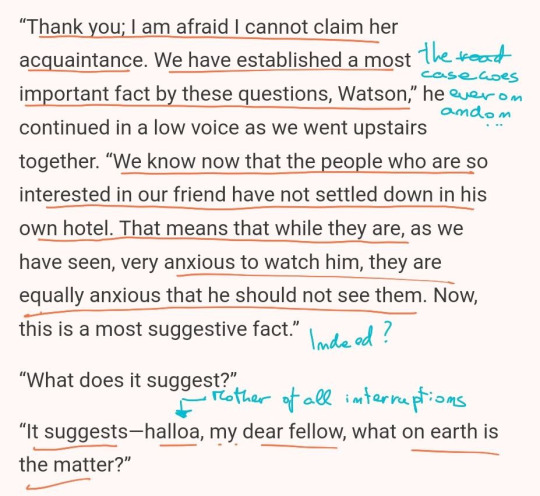
Not gossiping, ofc, GETTING INFORMATION. You can't change my mind on Holmes being one of the best gossips in London when he feels like that!
Now we did get some int- WHAT THE HELL IS HAPPENING NOW?!

They nicked ANOTHER boot?!

They did!
well, someone stops the american, pls?
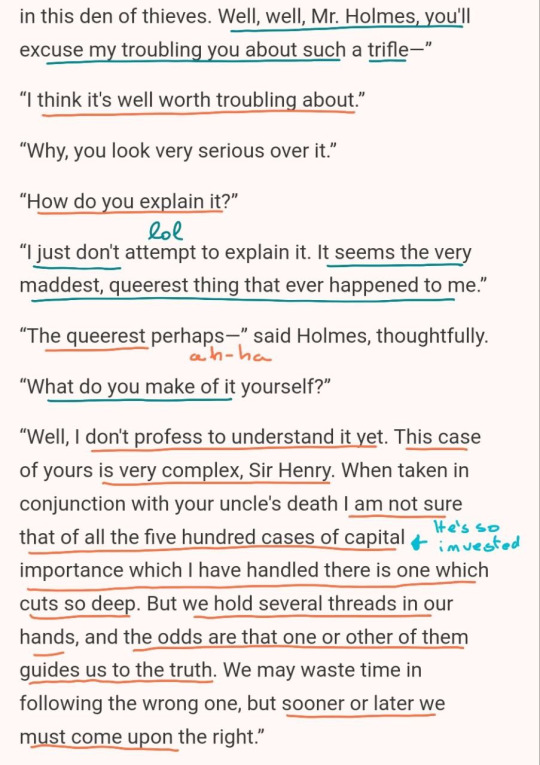
We have a CASE to solve! And Holmes is so, so happy and invested! all very nice!
NOW. Sir Henry decided to go to Devonshire at the end. And there's nothing we can do about it. But still we have to put set stuff straight. Like, you know you're dogged, right?
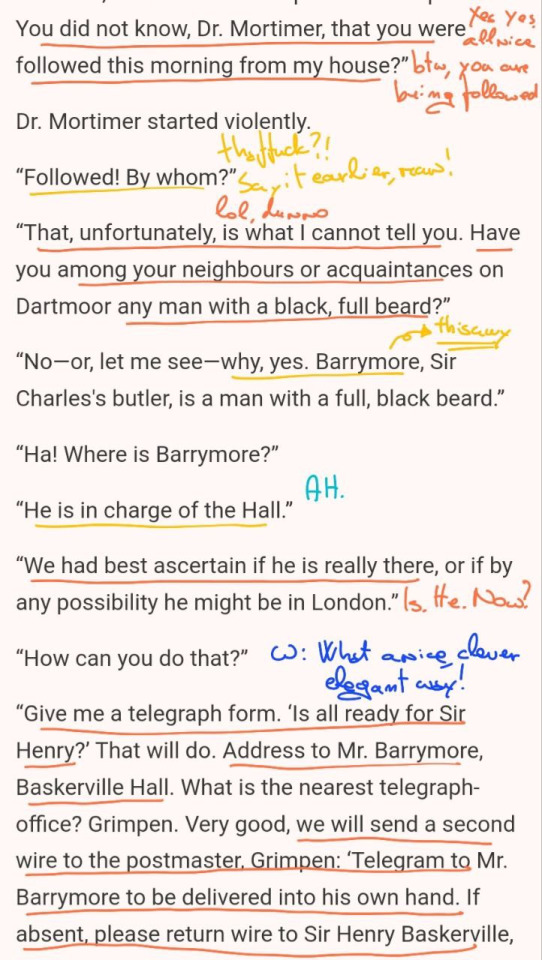
DOGGED?! WHAT? BY WHO?! W- AAAH
Okay, do write this telegram, there's noooothing that can go wrong!
BTW, -getting some tea-, tell me about this Barrymore!

LET ME GET THAT AMERICAN BASTARD'S NECK I'LL TIE IT INTO KNOT.
SPOILED RICH BRAT, NEVER HAD TO CARE FOR A FLAT, HAVE YOU? YOU'D KNOW THAT EVEN KEEPING SUCH A HALL LIVABLE TAKES ONE HECK OF A JOB YOU- -i am forcibly shut down-

Now inquiring for a motive.
Mortimer, lad. That is suspicious to say. a lot. That is EXACTLY Holmes' job and he's doing it WELL! How much money did Sir Charles have at the end?

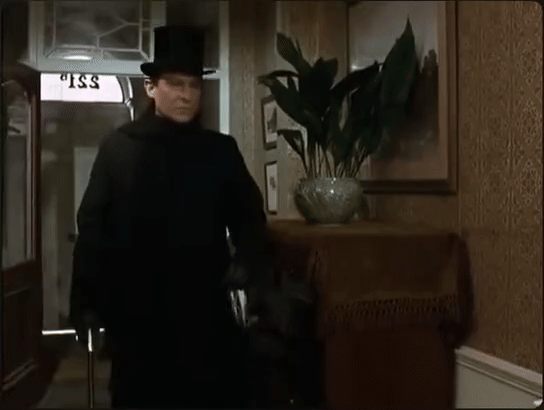

Holmes and Watson both going 'the hell? do people with so much money EXIST?!'
As Jeremy reminds us:
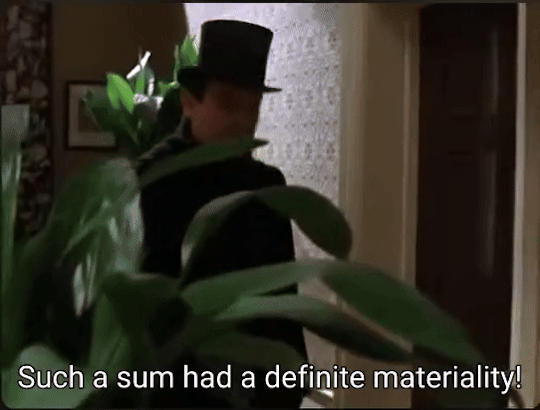
And it DOES! That's one hell of a motive! It's close to a million of motives!
NOW! You SHOULD go, sir Henry, but not alone!
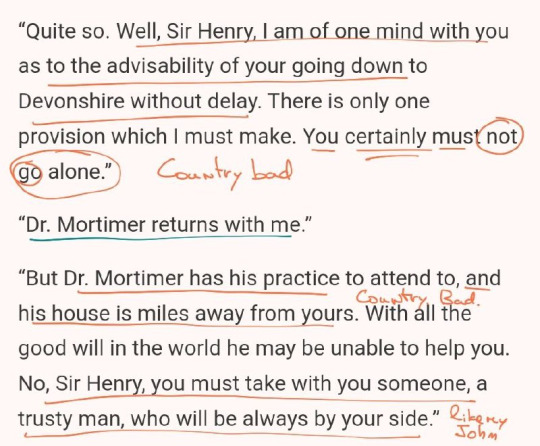
And i SURE can't come... i am... BUSY, YES, SOOOO BUSY!
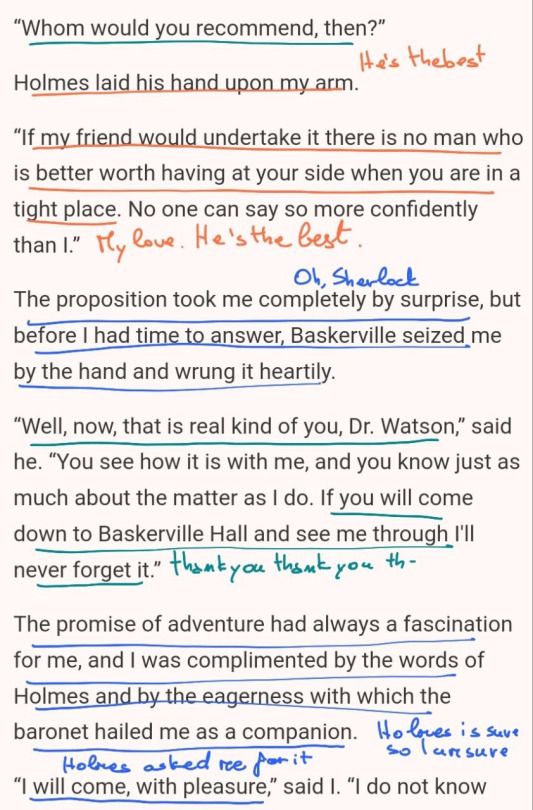

They agree for leaving on Saturday and the investigation goes ooooon! Two telegrams arrive to prove that two ideas can't work and yes, let's take it PHILOSOPHICALLY!
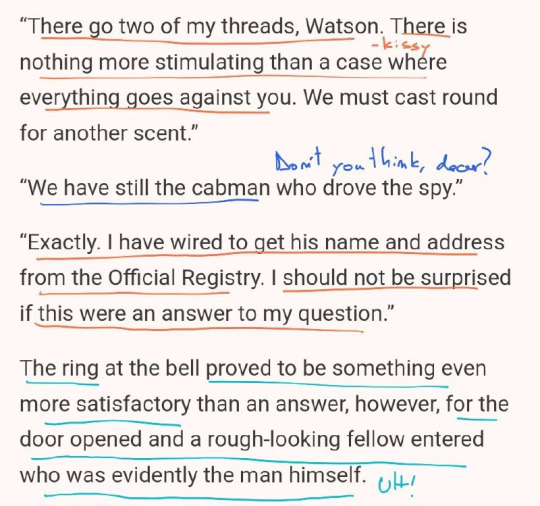
We still have one more threat in our hands! -Holmes giving Watson tiny kisses -
Here's the third thread!

Nothing against you my man! Just few answers, you had a guy on with you, yes, right. Ah, he said he was a detective.
Anything else?

WHAT IN THE EVERLOVING HELL?!
Okay. Damn. Okay. Time to send in some fencing metaphors! Damn. three on three gone!
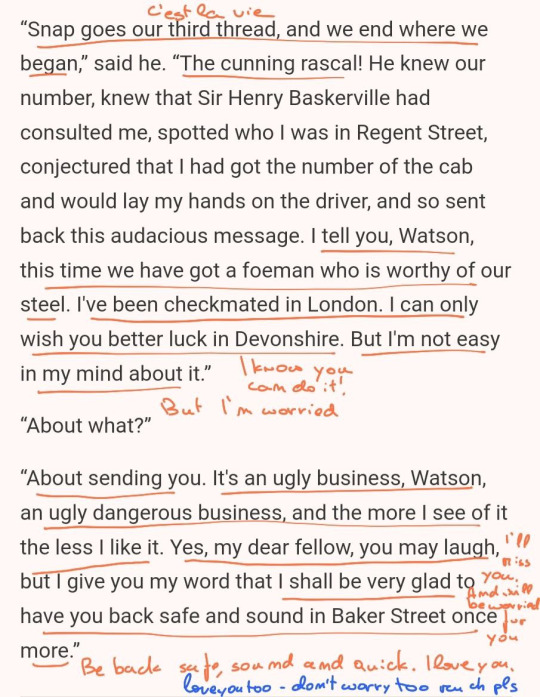
it IS an ugly and dangerous busyness. Holmes will be very very worried until it won't be solved. everything will be well!
We'll see how it'll go in the next episode!
#letters from watson#victorian husbands#jeremy brett#unnecessarily handsome#edward hardwicke#the dark side with kind eyes#asexual falling hard for actors from an 80s show#sherlock holmes#dr watson#john watson#fencing metaphors#holmes is very excited about this case#and remember children#yaoi goggles stay ON
24 notes
·
View notes
Text
I'm watching the Granada adaption of the Copper Beeches and Holmes is yelling at Watson and going on this long monologue about how the great age of crime has past and all the criminals are pathetic losers now. Beeches is from the first short story collection, Holmes is still relatively early in his career. Dude hasn't faced the hound of the Baskervilles or Charles Augustis Milverton or flipping Moriarty. Dude's just grumpy he hasn't had a case in a few days and is proclaiming no more criminals exist and the universe took that personally.
56 notes
·
View notes
Text
Still liable to changes, but I have at last placed every single story into my chronology! I have also made some changes to the order of stories placed previously, based either on new information or their vibes. Comments and feedback are much appreciated.
The ‘Gloria Scott’ - Summer 1875 [1] (Framing: Winter 1882-3?)
The maths as stated don’t work, as 1855 + 30 = 1885, and these events can’t occur after A Study In Scarlet. 1875 would have to be Holmes’s second year of college.
The Musgrave Ritual - Spring 1879 (Framing: Winter 1882-3?)
It is stated to have been four years since Holmes last saw Musgrave. Holmes mentions telling Watson about the events of ‘Gloria Scott’. Watson must be living at 221b at the time, as his intro describes Holmes’s extremely messy habits in terms of lodging with him.
A Study In Scarlet - January to March 1881
Watson states the date he discovered Holmes’s profession explicitly as the 4th of March, which was several weeks after they moved in together. I find it likely that it was at most mid-January when they met, and that Watson spent February observing Holmes’s habits and trying to figure him out.
The Resident Patient - October 1881
Watson describes these events as being ‘towards the end of the first year during which Holmes and I shared chambers’, and then specifies that it was October.
The Valley Of Fear - January 1882 [2]
It is stated to be ‘in the late eighties’, but Holmes appears to still be getting used to Watson’s sense of humour, which he claims is ‘developing’, which points to it being earlier while Watson is still recovering from his illness. Any later and Holmes would already be very familiar with his closest companion’s personality. It cannot be any earlier than 1882 however, since January 1881 is taken up by the events of A Study In Scarlet.
The Speckled Band - April 1883
The Yellow Face - Summer 1883
The Beryl Coronet - February 1884
The Copper Beeches - Early Spring 1884
Charles Augustus Milverton - Winter 1884
I get the feeling this is an earlier case, as Watson’s attitude is oddly naïve when it comes to morality and the ability of the law to handle Milverton. I cannot see him behaving like this/holding these beliefs if he has already experienced Moriarty with Holmes for instance. He is also very jumpy while he and Holmes are performing their burglary.
The Hound Of The Baskervilles - October 1885 [3]
Mortimer’s stick is dated 1884, and Holmes notes this was five years ago (making it 1889), but Watson neither appears to be married nor in medical practice, and since this story was explicitly written as to have occurred before Holmes’s ‘death’, this precludes it being set after 1888.
The Greek Interpreter - Summer 1886?
The Reigate Squires - April 1887
The Sign Of Four - July 1887 [4]
It is stated to be July (later mistakenly stated as September) 1888, but this contradicts both SCAN (March 1888) and FIVE (September 1887). There also appears to be a pearl missing as Mary describes their delivery.
The Cardboard Box - August 1887
Holmes mentions both A Study In Scarlet and The Sign Of Four by name -- which implies that Watson is a very speedy writer, as this would be only a few weeks later. However, this may be taken as self promotion on Watson’s part.
The Noble Bachelor - Autumn 1887
This story is dated to 1887 via Lord St. Simon’s age, but Watson is soon to be married -- which is not possible if he has not yet met his fiancée. Dating SIGN to July 1887 fixes this discrepancy.
A Scandal In Bohemia - March 1888
Watson explicitly dates the start of this case to the 20th of March 1888, and states that he hasn’t seen Holmes for several months after his marriage (which would be in the late autumn to winter of 1887)
The Stockbroker’s Clerk - June 1888
Watson states that he acquired his practice ‘shortly after’ his marriage, and that he was too busy to visit Holmes at Baker Street for three months. Counting most of March as the first month (per SCAN), that takes us to the June he states, which is the first time Holmes has visited Watson at his practice.
The Naval Treaty - July 1888
[The Second Stain - July 1888**]
I take it that the story of this name is heavily if not entirely fictionalised. This is when the real events that inspired it occurred.
The Crooked Man - Summer (August?) 1888
The Five Orange Pips - September 1888 [5]
It is stated to be September 1887, but even if SIGN occurred in July of that year, Watson and Mary have not married yet for him to be ‘staying at Baker Street’ while she is away visiting her (dead) mother.
The Boscombe Valley Mystery - Spring 1889
The Man With The Twisted Lip - June 1889
I place this after BOSC, as Holmes takes it as a given that Watson’s wife will not object to him sending a note and running off on a case in the middle of the night. (I suspect he’s wrong and will be due a bollocking after breakfast)
The Engineer’s Thumb - Summer 1889
The Dying Detective - November 1889
Watson describes this as happening in his ‘second year of marriage’, which, 1888 being his first, works out as 1889.
A Case Of Identity - September 1890
Holmes comments in REDH that the case of Mary Sutherland occurred ‘the other day’.
The Red-Headed League - October 1890
The Blue Carbuncle - December 1890
Watson states it to be ‘the second morning after Christmas’, making it the 27th. When discussing cases that didn’t involve a crime, Holmes cites the events of SCAN, IDEN, and TWIS. This also lines up with the publication order, BLUE being the seventh short story, and Watson states that of the ‘last six cases’ he has written up, three of them were legally free of crime (morally however…)
The Final Problem - April to May 1891
Holmes has apparently been working in France since ‘the winter of 1890’ when he suddenly shows up in Watson’s consulting room on the 24th of April. His ‘death’ occurs on the 4th of May.
The Empty House - March 1894
The Norwood Builder - Summer 1894
Stated to take place ‘several months’ after Holmes’s return. Watson has moved back to Baker Street and sold his practice.
Silver Blaze - Late Summer 1894
(I would like to set Silver Blaze to be after NORW, since I think Holmes and Watson deserve a fun case after that one. I believe it to be post-hiatus since Watson is evidently resident in Baker Street and does not appear to be in practice at this time.)
The Golden Pince-Nez - November 1894
The Red Circle - Winter 1894
Watson is living at Baker Street, and Holmes refers to his medical practice in the past tense.
The Solitary Cyclist - April 1895
The Three Students - 1895
Black Peter - July 1895
The Bruce-Partington Plans - November 1895
The Veiled Lodger - Early 1896
The Shoscombe Old Place - 1896
The Missing Three-Quarter - February 1896-7?
Described as occurring ‘seven or eight years ago’ from the time of writing, presumably 1904.
The Devil’s Foot - March 1897
The Abbey Grange - Winter 1897
Wisteria Lodge - March 1898 [6]
It is stated to be March 1892, but this is impossible as Holmes is presumed dead at that time. It also can’t be March ‘91 as Holmes is too busy at that time, and referencing REDH eliminates March ‘90 or any year earlier. Further, Holmes complains of boredom due to a lack of cases, which eliminates 1894 due to a very high number of cases in that year (he also would only have been back about two weeks at that point). Holmes is also busy in March ‘95, ‘96, and ‘97. It is not until 1898 that there may be time to be bored by March.
The Six Napoleons - Late May/Early June 1898
It must be the end of May or the start of June, as Beppo was arrested and sentenced to a year in prison in late May of the previous year. (I’d like to set this one near DANC, since Holmes deserves the praise.
The Dancing Men - July 1898
Mr Cubitt says that he met his wife while in London ‘for the jubilee last year’, and that Elsie received a letter from America ‘about a month ago, at the end of June’.
The Sussex Vampire - November 1898
I date this story to after 1897, as that is the year vampires rose significantly in the public consciousness.
The Retired Colourman - Summer 1899
Amberley married his wife in 1897, and Holmes comments that the events that have resulted in their contact with him have occurred ‘within two years’.
The Priory School - May 1901?
Years listed with regard to Lord Holdernesse date the story post 1900, and wording makes it seem that that is not the present year.
The Disappearance of Lady Frances Carfax - Spring/Summer 1901?
The Problem Of Thor Bridge - October 1901
The Three Garridebs - June 1902
The Illustrious Client - September 1902
The Blanched Soldier - January 1903
Holmes claims that Watson has ‘deserted [him] for a wife’.
The Mazarin Stone - Summer 1903
Watson is visiting Baker Street, and comments that nothing has changed in his absence, which infers this to occur after his second marriage. He also comments that a dummy of Holmes has been ‘used before’, referencing the events of EMPT.
The Three Gables - 1903?
Watson has not seen Holmes ‘in some days’.
The Creeping Man - September 1903
As originally published, the date is stated as September 1902, but when collected in Case-Book, this changes to 1903. I place it in 1903 as Watson is not living at Baker Street at this time, having been summoned by a note from Holmes.
The Lion’s Mane - July 1907
Holmes is retired
His Last Bow: The War Service Of Sherlock Holmes - August 1914
Holmes has been undercover for the past two years.
Additionally:
This chronology was started in direct opposition to and due to frustration with Baring-Gould's chronology. Any comments or suggestions based on it will be disregarded.
It is my aim with this chronology to take into account all stated dates, and take them as correct except for where they blatantly contradict others. (e.g. SIGN being dated to either July or September 1888, when FIVE references Watson's wife in September 1887 and SCAN refers to his marriage in March 1888; Wisteria Lodge being dated to March 1892 when Holmes is 'dead' at this time)
It is also my intention that Watson is only married twice, the first time to Mary Morstan in late 1887 and the second to an unknown Mrs Watson in early 1903 (being strictly canonical, my own headcanons of him retiring to Sussex with Holmes aside)
I estimate that Holmes was born January 6th 1857, making him 18 at the time of GLOR and 24 at the time of STUD. Also by this estimate he would be 57 at the time of His Last Bow.
I estimate that Watson was born 23rd May 1853, making him 27 at the time of STUD. This would make him 61 at the time of His Last Bow.
#sherlock holmes#acd canon#acd holmes#i reject your chronology and substitute my own#watson's birthday is pure headcanon#i just thought it would be fun for it to be the day after acd's#i have not got my maths wrong for his age in study by the way - he just hasn't had his birthday yet
94 notes
·
View notes